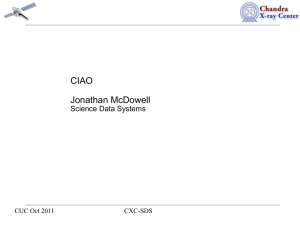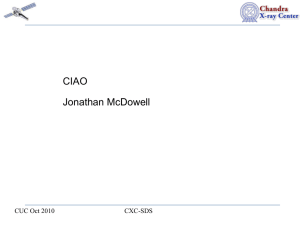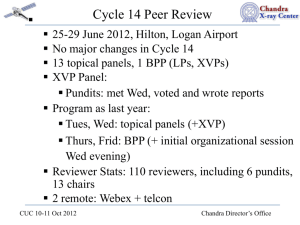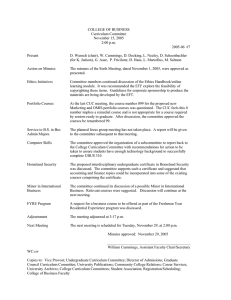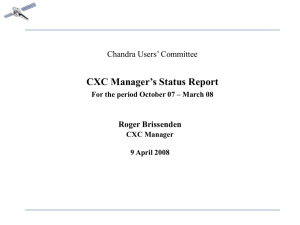CIAO (and scripts) Update Jonathan McDowell CXC Science Data Systems
advertisement
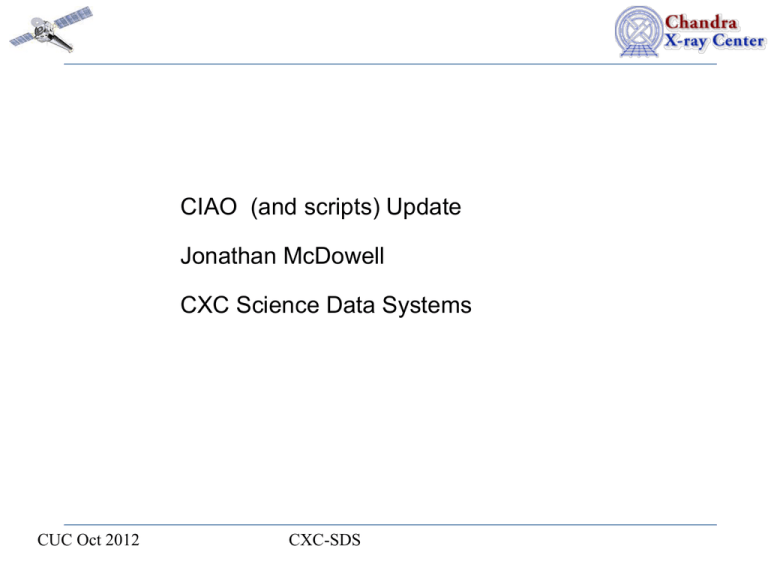
CIAO (and scripts) Update Jonathan McDowell CXC Science Data Systems CUC Oct 2012 CXC-SDS Science Data Systems: Supporting the users from data download to publication - Scientific integrity of the standard processing pipeline, including response to changing calibration and newly identified instrumental effects - Response to changing user requirements and community expectations - new algorithms, new science questions, new computing environments, joint analysis/data interoperability with new missions - making X-ray astronomy analysis easier, to grow the community - SDS provides algorithms and specifications, and carries out testing and documentation - “Threads” - cookbook approaches to carrying out X-ray analysis - Scripts - lowering the bar to entry for astronomers from other wavebands - Helpdesk – direct support to users' analysis problems - Workshops and booths – face-to-face software and analysis training for users - Some support for proposal planning tools CUC Oct 2012 CIAO 4.4 Downloads CIAO 4.4.1 is the current supported release. Downloads of CIAO 4.3 (released 2010), CIAO 4.4 (released 2011 Dec 15) and CIAO 4.4.1 (released 2012 Jun 27) Stats from 2011 Sep 1 to 2012 Sep 1: Linux Mac Solaris Source build Total CIAO 4.3 330 169 2 34 535 CIAO 4.4, 4.4.1 695 (of which 310 are 32-bit) 464 (of which 39 were 32-bit) 0 No longer supported 89 1248 Currently Linux builds are on CentOS; no portability problems seen on recent Fedora and Ubuntu-derived releases MacOS support for 10.6 Snow Leopard, 10.7 Lion Currently looking at 10.8 Mountain Lion – some issues seen CUC Oct 2012 CXC-SDS Total 1025 633 2 123 1783 CIAO downloads versus time - Steady demand year-round at 100 downloads/month - plus a spike during proposal season SDS Group •Staff changes: Kenny Glotfelty transferred from DS team to replace Liz Galle as lead computer specialist. Liz was our lead helpdesk person and web developer for 11 years. - in additional duties, Kenny will be test lead (replacing M. Karovska), and will have lead responsibility for SDS planning for the long term CIAO future (including an eventual HEASARC transition). Kenny brings a comprehensive knowledge of the history of the system. Margarita Karovska is transitioning off CXC in October due to budget reductions and her duties will be shared among the remaining team CUC Oct 2012 CXC-SDS CIAO Documentation • Tested, documented and updated reports on known software bugs, advertised bug updates •Documented DS releases, CALDB releases and CIAO script updates (release notes, threads, why topics) •Improved various threads and explanations following user feedback; documented HRC tap calibration issue • New thread and other docs on the effects of focal plane temperature variation during an observation and what to do about it... – ACIS FPTEMP now warms significantly at perigee, to values outside calibrated range – Can identify affected time intervals and create time filter to remove them for analysis problems that require the most accurate calibration • Documenting interactive/GUI features, like the interaction of CIAO with the ds9 imager, is challenging. The best way is to be at a CIAO workshop with an expert standing behind you explaining. We have attempted to capture this experience on a YouTube channel (next slide) CUC Oct 2012 CXC-SDS CIAO Documentation - YouTube • www.youtube.com/user/4ciaodemos CUC Oct 2012 CXC-SDS CIAO Documentation - PSF • PSF Tools and Analysis: Several tools, analysis packages and threads exist across the CXC teams to help users simulate the on orbit optical performance of Chandra: – SAOTrace (v.1 and v.2) – CXC Optics Team software suite for ray-trace simulation of the HRMA mirrors, now (v.2) enhanced to allow aspect dithering of the rays – MARX (v.5) – CXC MIT SDS/HETG team software suite for end to end ray trace simulation including HRMA (lower fidelity than SAOTrace), gratings and detectors. – CHART (v1) – CXC SDS web interface which performs an SAOTrace run so users can download rays for input to the MARX instrument simulator to create a simulated point source Chandra event file. – psf_project_ray – Projects ChaRT rays onto the instrument focal plane including detector geometry but not detector instrumental effects – arfcorr, mkpsf and related tools: uses precomputed SAOTrace-generated data on encircled energy vs radius, pos. to estimate aperture correction for PSF in a region • Existing analysis threads discuss making a PSF image, 1D and 2D fitting of PSF, estimating PSF aperture correction; and individual help files describe all the low level tools and components. Over the next several months we plan to consolidate this information and put it in context to help users pick the correct simulation and analysis approach for their scientific needs. CUC Oct 2012 CXC-SDS Community Support • Helpdesk: 317 new tickets (Sep 15-Sep 1), • – – » » » » » – – – CUC Oct 2012 7 still open Median time to first answer 1 hour (longest 7 days, tracking down software issue) Median time to final answer 6 hours, longest in past 6 mo was 26 days (waiting for user to follow up) Answers generated 15 new docs, 12 new bugs, 9 RFEs what were the bugs? examples: - chandra_repro script didn't handle VFAINT filtering - setup script failed when ksh not available - CALDB indexing error - Sherpa issue with XMM file (different convention used) about 70% did not require scientist or DS support 13 open tickets from previous period all now closed We also get direct contacts to SDS scientists outside the helpdesk system, at the rate of several per week CXC-SDS Community Support • 9th CIAO workshop scheduled for Apr 22-24, 2013 • Introduction to X-ray data analysis and the CIAO package • Advanced talks on data analysis and statistics • Chandra calibration issues • Hands-on sessions • The workshops are about 50/50 talks and hands-on • We provide sample analysis exercises but encourange attendees to bring their own data if they have any • Attendees are typically grad students and postdocs CUC Oct 2012 CXC-SDS CIAO Release • Supported CIAO 4.4 release (Dec 2011 ) • Supported CIAO 4.4.1 patch release Science testing of tools and Sherpa Regression test carried out on Mac and Linux platforms Download testing carried out on scientist's home systems (Mac and Linux) Documentation and other release support as usual •CIAO 4.5 release will follow the usual annual cycle with documentation, test and release support coordinated with Data Systems development and test, and culminating in our mid-December release CUC Oct 2012 CXC-SDS CIAO and science analysis planning • CIAO 4.5 release is mostly maintenance from the science point of view – SDS focus on scripts and longer term R&D – Zero order tool for pipeline, currently iterating in testing – Improvements to header keyword handling to support mosaicing • CIAO and Pipeline R&D continues for 2013 – Continue work on 'Delta overclock' ACIS issue for pipeline – Improved error calculations in Sherpa – Comparing different background estimation methods as part of project to better support extended source analysis – Planning improved documentation for PSF simulation, esp. MARX – Reviewing analysis threads for missing capabilities CUC Oct 2012 CXC-SDS CIAO Scripts - Updates Full release content (see http://cxc.harvard.edu/ciao/download/scripts/history.html for details). Contains new and updated scripts: • chandra_repro script applies latest calibrations – implemented new afterlow tools (Dec 2011) – changed default to NOT apply 'VFAINT background filtering' – the filtering slightly improves S/N for faint sources in VFAINT mode but removes valid events for bright piled-up sources. Following review of a helpdesk ticket we decided it was more conservative not to do this by default. • fluximage – minor bug fixes, some improvements • find_chandra_obsid - wraps Chandra Footprint Service • download_chandra_obsid gets observations from the archive – enhanced to support stacks (lists of multiple files) • chips – new 'imexent' routine improves handling of image coordinates • combine_spectra - fix to improve compability with XSpec following helpdesk ticket CUC Oct 2012 CXC-SDS CIAO Scripts: The Plan - Scripts built on python infrastructure on top of compiled CIAO tools - Medium level scripts wrap CIAO threads in a single command line: deflare, specextract, get_fov_limits, acis_bkgrnd_lookup, splitroi, modelflux - Enhancements planned: script to facilitate WCS fine alignment script to calculate PSF fraction in easier ways script to tune blank sky backgrounds to match observation script to run SAOTrace and Marx to make ray-traced PSF script to make temperature maps - High level scripts to make common tasks easier, with slightly less ability to tune parameters. We started with simplifying the early parts of the analysis process We have continued with making it easier to combine split observations Next step is to make source analysis easier - Attack the messiest parts of the process first - Considering very high level scripts (like acis_extract) further down the road - Considering scripts to handle multi-observation analysis without merging - Will attack other areas as needed - welcome suggestions on priorities CUC Oct 2012 CXC-SDS CIAO Scripts: High level --- Observation processing --• • • • • • • find_chandra_obsid (2012) - given a source name, find obsids download_chandra_obsid (2010) - given obsid, download data chandra_repro (2010) - apply latest calibrations to downloaded data, make new evt2 fluximage (2011) - exposure corrected image srcflux (2013) get count rates and fluxes for a point source background_model (under consideration) – matching particle background to obsn; possibly model cosmic background too? grating_specextract (under consideration) – make TGCAT style products --• • • Merging observations ---merge_obs (late 2012) – mosaic different observations, exposure correct combine_spectra (2010) combine multiple PHA/ARF/RMF combine_grating_spectra (late 2012) – combine orders, observations CUC Oct 2012 CXC-SDS Combining Observations The legacy script merge_all is used to combine observations but it has many limitations - only works for observations with similar pointing directions and with the same SIM position - does not take the bad pixel masks correctly into account The new merge_obs script is undergoing final testing and is ready for release It allows users to easily create fluxed mosaic images of large regions Given a list of event files, it - automatically locates needed auxiliary files in the same directory, - reprojects to a central position, and - makes exposure-corrected and exposure-thresholded images in one or several userspecified bands CUC Oct 2012 CXC-SDS Combining Observations – Example 1 merge_all does fine in this case where two observations are coadded There are small errors in the handling of the exposure map The new script thresholds the edges so you don't get the spurious high pixels there CUC Oct 2012 CXC-SDS Combining Observations – Example 2 Adding in two further observations starts to show limitations: obsid no 3 has a different SIM position and obsid 4 is a subarray; the new script handles the exposure maps and reprojection correctly in these cases CUC Oct 2012 CXC-SDS Old script does work fairly well as long as SIM Z is the same for all obsids and total field does not cover multiple degrees But dead area and accurate exposure correction give 10 percent improvements in new script These images show fluxed images on the left and fractional difference (between new and old scripts) on the right Combining Observations – Example 3 COSMOS survey fields 49 observations 3-color image using CSC bands CUC Oct 2012 CXC-SDS Combining Observations – Example 3 cont. The same data with a different stretch, showing that one observation has a higher background level. In future work we hope to use the particle-background-dominated 10-12 keV flux to automatically model and remove the instrumental component of the background CUC Oct 2012 CXC-SDS Combining Observations – Example 4 Eta Carina Raw counts (left) Exposure map (right) CUC Oct 2012 CXC-SDS Combining Observations – Example 4 cont Eta Carina 40 ACIS-I datasets 1999-2008 Mix of FAINT and VFAINT Exposure times from 10 to 90 ks Input was simple list of event files: ls */*evt2* > lis merge @lis”[ccd_id=:4]” out Result is a set of 1363 x 1537 pixel images (size autocalculated to cover the field) CXC Quarterly Report Sep 2012 CXC-SDS Combining Observations – Example 5. Wide scale, coarse binned mosaic: Polaris and neighbours Demonstration tests that mosaicing code handles polar case robustly CUC Oct 2012 CXC-SDS Combining Observations – Summary. The new merge_obs script - parallelizes the computation across multiple processors on the host machine - automatically determines the center and size of the mosaic (if the user doesn't specify) by averaging the unit vectors of the pointing directions and taking the union of the reprojected field-of-view polygons - modifies headers to account for the fact that the 'sky' pixel coords go beyond their normal range (which can cause ds9 not to display part of the image) - automatically handles different event input formats by trimming columns as needed - automatic location and use of mask, aspect, bad pixel, parameter block files using values seeded in event file header - sorts input files in time order - for HRC-I, subtract particle background model - thresholds final image using exposure map (default 1.5% of max exposure) - cleans up intermediate files on exit - supports standard catalog energy bands e.g. 'CSC', 'soft' as well as user-specified ones; can use spectral weight files for exposure maps if supplied Limitations: Cannot combine ACIS with HRC-I/S, or HRC-I with HRC-S No ACIS background subtraction No support yet for improving astrometry before merging CUC Oct 2012 CXC-SDS Sherpa and ChIPS Sherpa – the general purpose parameter fitting application - continued improvements - science uptake increasing (38 refereed pubs so far in 2012) ChIPS – our line plotting and imaging application - updated website for CIAO 4.4 - GUI released as planned in CIAO4.4 (Dec 2011) - No major SDS work planned for ChIPS this year CUC Oct 2012 CXC-SDS Sherpa 2012 Development • Sherpa is our multipurpose parameter-fitting application • • • • • • Carried out bug review – closed 50 bugs/RFEs, 152 remained Limited DS resources for Sherpa this year, so SDS focus on R&D - Research into broad band SED fitting - Research into ACIS background modelling within Sherpa - Delivered specs for flux error and equivalent-width error simulation functions - Application of MCMC methods in Sherpa • Documentation work on Sherpa: – Thread on using parallelization in Sherpa http://cxc.cfa.harvard.edu/sherpa/threads/multicore – Updated ahelp files for new XSPEC models CUC Oct 2012 CXC-SDS Sherpa R&D C-stat goodness of fit Simulations: BF sensitivity for an emission line Bayes Factors (probability of model M1 vs. M2) for Hypothesis Testing and Model Selection: • Highly dependent on the selection of priors. • Comparison to posterior predictive p-values which is using MCMC simulations for model selection CUC Oct 2012 CXC-SDS Sherpa Applications Examples The most recent examples of Sherpa use found on ADS 38 articles published in 2012 I'll present some examples of how Sherpa is being used in the community CUC Oct 2012 CXC-SDS Sherpa Application Examples • 2D Image Fitting Sanders & Fabian 2012, MNRAS, 421, 726 Deep Chandra and XMM-Newton X-ray observations of AWM 7 I. Investigating X-ray surface brightness fluctuations O’Sullivan et al 2011, MNRAS 416, 2916 Interaction between the intergalactic medium and central radio source in the NGC 4261 group of galaxies 2D Beta models fits and residual maps Surface Brightness profile from the 2D model fits CUC Oct 2012 CXC-SDS to Chandra and XMM Images Sherpa Application Examples Simulations to obtain the uncertainties on measured flux Comerford et al 2011, ApJ. 737, 19 Chandra Observations of a 1.9 kpc Separation Double X-Ray Source in a Candidate Dual Active Galactic Nucleus Galaxy at z = 0.16 Two-component Beta model fit to Chandra image and “sample_energy_flux” used to obtain uncertainties on the flux of each component CUC Oct 2012 CXC-SDS Sherpa Application Examples 1D Spectral and 2D Image Fitting Chen et al. 2012ApJ...755...24C X-Ray Monitoring of Gravitational Lenses with Chandra Fit quasars spectra - looking for microlensing event in the Fe-line emission CUC Oct 2012 Fit the Chandra images of 6 gravitational lenses CXC-SDS Sherpa Application Examples Templates: SED fitting Trichas et al 2012 ApJS, submitted Optical Spectroscopy and broadband SEDs of X-ray Selected AGN suggest QSO-Feedback Quenching of Star Formation Sy 2 template Sy 2 + Starburst templates fit Template user models were developed by the users and applied to the data using Sherpa in CIAO 4.3 Sherpa in CIAO 4.4 supports such models CUC Oct 2012 CXC-SDS Sherpa Application Examples Sherpa modeling of HESS TeV data H.E.S.S. Collaboration, A&A 541, A5 Discovery of VHE emission towards the Carina arm region with the H.E.S.S. telescope array: HESS J1018-589 Image fitting CUC Oct 2012 CXC-SDS Sherpa Application Examples Modeling Chandra Grating Spectra Oruru & Meintjes, 2012, MNRAS, 421, 1557 X-ray characteristics and the spectral energy distribution of AE Aquarii Hussain et al. 2012, MNRAS, 423,493 Chandra study of the eclipsing M dwarf binary, YY Gem Modeling line profiles in HEG and MEG spectra CUC Oct 2012 CXC-SDS Sherpa Application Examples Recent Examples of User developed models: Logparabola - Massaro et al. 2012, ApJ. in press (arXiv1203.1627) X-ray spectral curvature of High Frequency Peaked BL Lacs: a predictor for the TeV flux Cooling curves - Fridriksson et al. 2011 ApJ, 736 162 The Variable Quiescent X-Ray Emission of the Neutron Star Transient XTE J1701-462 Spin-down pulsars model - Zabalza et al. 2011, ApJ. 743, 7 Thermal X-Ray Emission from the Shocked Stellar Wind of Pulsar Gamma-Ray Binaries Cooling Curve fit to a neutron star Logparabola fit to blazar spectra - the model has been added to Sherpa in CIAO 4.4 CUC Oct 2012 CXC-SDS Spin Down Model PSF tools and analysis Continued research into high spatial resolution analysis: - Tested improvement of HRC-I model PSFs to data following instrumenta calibration (degap) update and confirmed that the core is narrower. .- Presented paper on MARX ray trace at SPIE meeting Further investigation of 0.7” PSF artifact. ACIS data on CH Cyg compared to a flat power law shows evidence for a soft spectrum; planning Cal observation of a harder source with both ACIS and HRC to give stronger constraints. MARX 5.0 dither now able to correctly model chip edge using dither model. Improved treatment of HRC detector in MARX simulator Gaussian blur replaced by gaussian + gaussian + Lorentzian based on a Sherpa fit to the HRC data by V Kashyap ACIS – Supporting a Changing Instrument Cal identified time variation of ACIS QE's spatial dependence Implementing and testing correction for pipeline Discussing whether multiple epochs are sufficient or time interpolation is needed Afterglows The acis_find_afterglow tool was released with CIAO4.4. Improvements continued late in the testing cycle: - ignoring events on bad columns while searching for afterglows - ignoring mid-chip-boundary events - change to pipeline to run destreak before instead of after - correctly ignoring S4 chip streak events - handling some pathological cases Improvements deferred to future versions: - Hot pixels that also have many afterglows may not be marked hot - Cases of many events in a column for one frame, probably instrumental artifact - Afterglows that are at different times but spatially adjacent may currently be incorrectly combined. Extensive set of automated tests was developed for the program covering full range of input parameters. For example, confirmed that Cas A events are not misidentified as afterglow/hotpix; looked at many-point-source obs and confirmed that afterglows identified there are not real sources. Updated ahelp, Why documents for afterglows and streaks, and appropriate threads. chandra_repro script has also been updated to address the changes. • • • Gratings RMF includes aperture correction Small subset of HETG observations are bright, but not too bright, to compare arms vs. 0th order calibration with arfcor arfcorr improves calibration agreement, when fitting identical physical models. Grating zero order calibration Sgr A* observations: ACIS-I CCD (blue) and ACIS-S/HETG Order 0 (red) show good agreement Grating zero order calibration Source: Supernova 1987a, versus time Fit to HETG zero order data using model from HETG first order data and pileup correction Preliminary analysis, agreement within 10 percent; source is complex in sky and velocity space TGCAT TGCAT continues to be kept up to date as new grating data go public – currently 1351 Obsids (939 HETG, 138 ACIS/LETG, 274 HRC/LETG) for 382 distinct sources Increase of 98 obsids and 14 sources since last report. Archive is 198 Gb. (The data were reprocessed in Feb 2012 with the new grating efficiencies) TGCAT queries: 12100 from 691 ip addresses (1 Mar to 1 Sep) – mostly using VO interface (8241 VO, 3439 web, 420 CLI) TGCAT downloads: 66 GB packages and 4 GB single files, total 1572 downloads BACKUP: SDS Catalog Support (See I. Evans talk) Chandra Source Catalog: SDS Support • Spec for new limiting sensitivity tool delivered to DS and reviewed. Algorithm is similar to that used in 2XMM catalog (Carrera et al. 2007, A&A, 469,27). • Tool now in development. • Continued work on algorithms for multi-obsid detect and compact source detection near regions of bright extended emission: – Identify extended emission region using mkvtbkg; – Within extended region, use extension of mkvtbkg algorithm to identify compact sources. • Developed prototype for new aperture photometry tool: – More robust than aprates; – Can determine intensities from multiple sources in overlapping source regions; – Can accept informative priors from previous observations (this part is still in development) – Resulting probability distributions used in derivation of source colors and inter-observation variability, making the catalog more self-consistent. Chandra Source Catalog: SDS Support • Spec for new limiting sensitivity tool delivered to DS and reviewed. Algorithm is similar to that used in 2XMM catalog (Carrera et al. 2007, A&A, 469,27). • Tool now in development. • Continued work on algorithms for multi-obsid detect and compact source detection near regions of bright extended emission: – Identify extended emission region using mkvtbkg; – Within extended region, use extension of mkvtbkg algorithm to identify compact sources. • Developed prototype for new aperture photometry tool: – More robust than aprates; – Can determine intensities from multiple sources in overlapping source regions; – Can accept informative priors from previous observations (this part is still in development) – Resulting probability distributions used in derivation of source colors and inter-observation variability, making the catalog more self-consistent. Fifth Outline Level Chandra Source Catalog: Aperture Photometry Sixth Outline Click to edit the outline text Click to edit the outline text Level format format Example simulation of two Chandra point sources Distribution of source counts determined from new separated by ~0.75”, at ~0.5’ off-axis, with true (solid) and Rel. Outline 1.1 (dashed) LevelClick aperture photometry Seventh to intensities of 100 and 30 counts, respectively. For algorithms for 500 simulations such as the one on the Second Outline Level new Second Outline Level edit Master texta tighter styles each source, the source region encloses ~90% of the left. The algorithm yields distribution PSF. that more accurately reflects the true source counts. Third Outline Level Third Outline Level Fourth Outline Level Fifth Outline Level Sixth Outline Level • Seventh Outline LevelClick to edit Master text styles Fourth Outline Level Fifth Outline Level Sixth Outline Level • Seventh Outline LevelClick to edit Master text styles – Second level – Second level – Third level – Third level Chandra Source Catalog: SDS Support Chandra Source Catalog: Detect experiments - Wavdetect has limitations for extended sources. Investigated a new algorithm 'mkvtbkg' using Voronoi Tesselation. - Identify all Voronoi polygons with smaller area than some threshold - Combine all such polygons that are touching to get extended source polygons - Measure of extent: compare average spatial variance of photons (sigma^2/N) with PSF area (50 pc encircled area e.g.) CUC Oct 2012 CXC-SDS Chandra Source Catalog: Detecting Compact Sources in Extended Emission • Define convex hull around extended emission using mkvtbkg • Use additional mkvtbkg contours to define compact sources (red crosses) within hull • Better at distinguishing between compact sources and statistical fluctuations due to, e.g., spiral arms (green wavdetect ellipses) •
